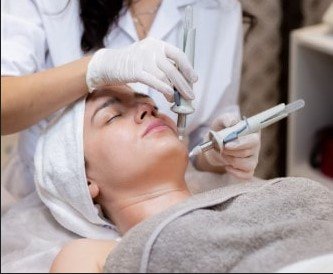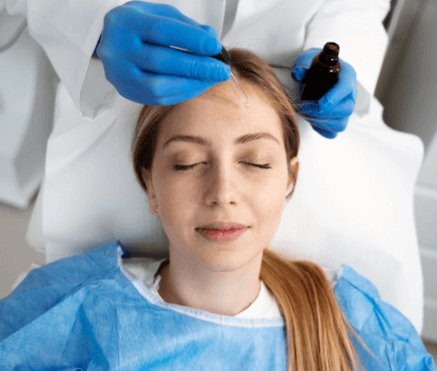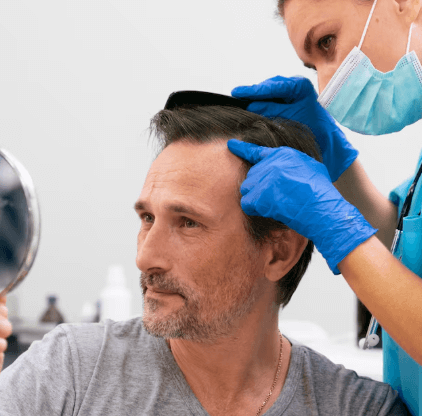Treatment Overview
Dermabrasion is a mechanical skin resurfacing procedure used in dermatology to treat post-inflammatory hyperpigmentation (PIH), acne scars, fine wrinkles, and uneven skin texture.
The technique uses a high-speed rotating device (diamond-tipped wheel or wire brush) to remove the top layers of skin. By exfoliating pigmented keratinocytes and triggering controlled wound healing, dermabrasion stimulates new, evenly pigmented skin growth.
In modern Korean dermatology, dermabrasion is less common than lasers (Pico, Nd:YAG, Fraxel), but it remains a valuable option for stubborn PIH combined with acne scars or texture issues, especially when patients want a non-laser resurfacing alternative.
Purpose & Benefits
- PIH Clearance: Removes superficial layers containing excess melanin.
- Scar & Texture Improvement: Smooths acne scars and roughness.
- Skin Renewal: Stimulates collagen remodeling and regeneration.
- Combination-Friendly: Often paired with chemical peels, CO₂, or lasers.
- One-Time Impact: Can produce noticeable results in a single session.
Ideal Candidates
Dermabrasion in Korea is recommended for:
- Patients with post-acne PIH + scars or textural irregularities.
- Adults with superficial pigmentation not fully responsive to peels or lasers.
- Individuals who prefer mechanical resurfacing instead of laser energy.
Possible Risks & Complications
Since dermabrasion is more invasive than peels or toning, risks can include:
- Redness & Swelling: May last 1–2 weeks.
- Scabbing/Crusting: Normal healing response.
- Skin Sensitivity: New skin may feel tender or pink for weeks.
- Temporary Hyperpigmentation or Hypopigmentation: Risk is higher in Asian skin; Korean dermatologists use conservative depth control to minimize this.
- Rare Scarring: If over-treated or if healing is disrupted.
Surgical Techniques Used
- Diamond-Tipped Wheel or Wire Brush: Gently abrades the epidermis and superficial dermis.
- Depth Control: Korean dermatologists carefully limit abrasion depth for Asian skin safety.
- Combination Use: Sometimes combined with peels or fractional CO₂ for pigment + scars.
- Protocol: Usually 1 session, though follow-up or touch-ups may be recommended after several months.
Recovery & Aftercare
- Immediately: Redness, swelling, raw or tender skin.
- 1–2 Weeks: Crusting, peeling, and regeneration of new skin.
- 3–4 Weeks: Noticeable improvement in pigmentation and texture.
Aftercare Tips:
- Apply healing ointments/barrier creams to support recovery.
- Strict SPF 50+ sunscreen use to prevent rebound PIH.
- Avoid makeup until skin heals (7–10 days).
- Avoid scrubbing, exfoliants, and retinoids for 2–3 weeks.
- Minimize sun exposure during recovery.
Results & Longevity
- After 1 Session: Visible fading of PIH + smoother texture.
- 3–6 Months: Continued collagen remodeling enhances results.
- Long-Term: Effects can last years, though new PIH may appear if acne recurs or UV damage occurs.
Treatment Process in Korea
Korean dermatologists specialize in safe dermabrasion protocols for PIH, combining it with modern pigment treatments for improved outcomes.
- Consultation & Skin Analysis
- PIH depth, acne history, and skin type evaluated.
- Dermabrasion considered if PIH is superficial and scar-related.
- Preparation
- Skin cleansing + local anesthesia or sedation (procedure can be uncomfortable).
- Protective measures applied.
- Dermabrasion Session
- High-speed diamond wheel gently abrades pigmented skin layers.
- Focused on PIH areas, sometimes full-face resurfacing for even results.
- Session lasts 30–60 minutes.
- Post-Treatment Care
- Cooling packs, healing creams, and sunscreen applied.
- Optional soothing drips or brightening infusions for recovery.
- Follow-Up
- Most patients require only 1 session.
- Resistant pigment may be treated with fractional CO₂ or Pico afterwards.
Unique Korean Advantages:
- Precision Resurfacing: Conservative depth settings to reduce PIH risk.
- Combination Programs: Dermabrasion often paired with peels, CO₂, or boosters.
- Affordable vs Western Clinics: Packages in Seoul cost significantly less.
- Reputation: Korea is a top choice for patients seeking integrated acne scar + PIH programs.
Cost Range (Estimated)
- Single Session (Full Face): USD 300 – 600
- Localized PIH Area: USD 150 – 300
- Premium Programs (Dermabrasion + CO₂/Pico/Boosters): USD 800 – 1,500
Additional Costs:
- Consultation: USD 20 – 50
- Add-ons:
- Whitening drips (Glutathione, Vitamin C): USD 100 – 200
- Skin boosters (Rejuran, PN, exosomes): USD 150 – 400
- Post-resurfacing healing kits: USD 50 – 100
Example Korean Programs:
- Basic PIH Dermabrasion (1 session): USD 400–500
- Advanced PIH Program (Dermabrasion + Whitening Drip): USD 700–1,000
- Premium PIH & Scar Program (Dermabrasion + CO₂ + Rejuran/Exosomes): USD 1,500–2,200
Popular Clinics in Seoul
- Oracle Dermatology: Dermabrasion + Pico for PIH + acne marks.
- Banobagi Dermatology: Resurfacing programs for pigment + scars.
- Renewme Skin Clinic: Dermabrasion + brightening infusions.
- View Plastic & Dermatology: Dermabrasion + CO₂ for pigment + scars/texture.
- Chaum Anti-Aging Center: Premium dermabrasion + regenerative boosters.




